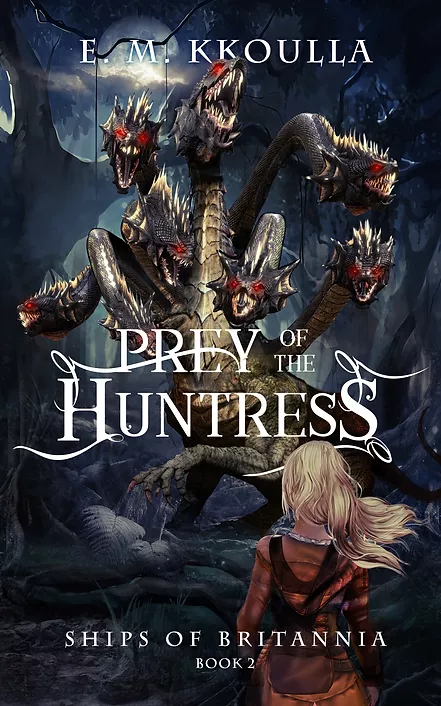Prey of the Huntress (Ships of Britannia #2), by E.M. Kkoulla
5 Oct 2022The Book

Synopsis:
Scarred and traumatised, Maia returns to finish her training. She hopes for a quiet life aboard HMS Blossom but, to her dismay, her fame has grown and she is hailed as a heroine for saving the Ship and her crew from the rage of the Livia.
Invitations flood in from the rich and powerful, who are eager to meet her before she is sent for initiation into the Sacred Mysteries.
Maia has already been warned that the Goddess Diana is her implacable enemy, and this time the Huntress intends that there can be no escape.
An ancient horror has woken. The board is set. The Gods are making their moves.
Only Maia’s courage can save her now.
My Review
Prey of the Huntress is the second book in the Ships of Britannia series, by the British author E.M. Kkoulla. Long story short, loved the first part (The Wrath of the Olympus), as it successfully merged elements which I personally like a lot, as it can be Gods, Roman culture, and steampunk, so coming back to this series and continue with the second book was just a matter of time.
The book starts at the point where we let Maia Abella, after being emplaced by Jupiter to become a living ship, so her Potentia can be controlled. Being a direct continuation of Wrath, the first three chapters serve as a sort of introduction to what Maia expects, what she is going to experience to become a piece of living wood; it also serves as a bridge between the plot of the first book and this second one. Other Gods stars moving pieces on the board, and soon Diana makes clear that she doesn’t want to allow Maia to become a ship.
The world on Ships of Britannia gets expanded in this book, showing us more details about how the Isles work, and some of the advancements that have happened since the timeline splits from the real worlds (seriously, I can stress how much I love the gunpowder). Worldbuilding is one of the main strengths of Kkoulla writing, resulting in a carefully crafted novel, where the small details are really on spot (as can be reflected by the expressions used by the characters; small examples as «For Goddess» or «Go to Hades«). In this book, the sobrenatural element is more present in comparison with the first one, appearing more monsters, and with the Gods gaining relevance. There’s a subplot also exploring how the old religions are surviving in the Britannic Islands, which also introduces a Fae element to the world, and which I hope gets explored more in the third book (adding also a rebellion against the Empire).
Talking again about Maia, we are going to follow closely how she is going to be persecuted by the goddess Diana, while at the same time she’s suffering all the pressure to become a living ship for the Royal Marine, adding even an extra when she’s chosen to become a Royal Ship, the highest status. I find especially interesting and well-written the trials she has to endure to become a living wood piece, as they become an opportunity to explore Maia’s sentiments and thoughts, her insecurities, and how they can be overcome. It is really vivid, and I love how it is treated in general.
In summary, Prey of the Huntress took the expectations I built with The Wrath of the Olympus, and absolutely fulfilled them. Personally, I think this book is an improvement over the first one, as once the world is established, the space to explore it has widened, and that gets reflected in this novel. If you like Roman culture, ships, and Gods, this is a great book to read. And of course, soon we will return to Britannia with the third book in this excellent series.
The Author/s

E. M. Kkoulla
E. M. Kkoulla lives with her husband and two feline overlords in the Calder Valley, West Yorkshire. After many years of teaching very small children, she decided to finally put her degree in Classical Studies, along with decades of re-enacting 16th and 17th-century life, to constructive use. Her hobbies include singing in various choirs, walking in the hills, and watching anything with gods, superheroes, and monsters trashing the landscape.
